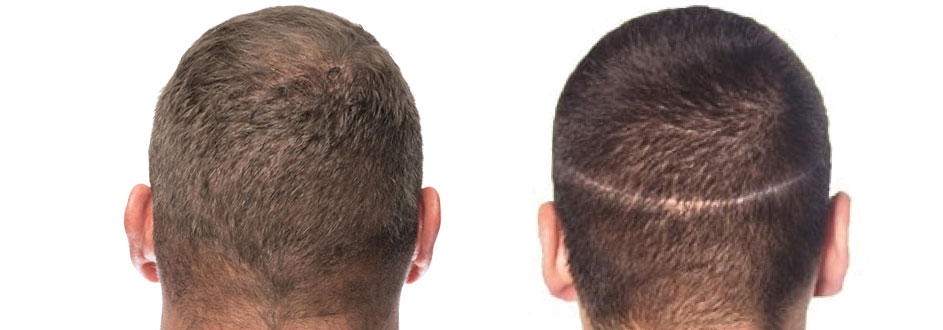When it comes to modern hair transplant techniques, there are two primary methods for extracting hair follicles during the transplant procedure:
- Follicular unit excision (FUE)
- Follicular unit transplantation (FUT)
These two procedures are similar in that they both offer completely natural-looking results. The implantation process is identical: Each follicular graft is placed artistically one by one in the recipient or thinning areas. The primary difference between FUE and FUT is the way in which hair follicles are extracted from the back of your head (also known as the “donor area”). However, there are other differences between the two methods to consider when deciding which method is best for you.
Advantages of FUE (vs. FUT/Strip)
- No linear scar in donor area
Important for those who wear their hair very short where the scar may become visible
Important for those who have a history of keloids, thickened or stretched scars
- Decreased healing time in the donor area
The small holes that are created with FUE will heal in much a shorter period of time than the linear FUT-strip scar.
- No limitations on strenuous exercise after the procedure
With a FUT-strip scar, strenuous exercise soon after the procedure can lead to the scar widening. The small holes created from the FUE procedure do not widen and are not affected by exercise after the procedure.
- Less post-op discomfort in the donor area
With FUE there is essentially no discomfort after the procedure
- Useful for those with a greater risk of donor scarring
Younger patients
Very muscular, athletic patients
Those with very tight scalps
Those with a history of keloid scarring or poor healing
- Useful for repairing donor scars that cannot be excised
If a patient has previously undergone a FUT procedure and has a widened donor scar, an FUE procedure can be performed to transplant hair into the scar to help camouflage it.
- Provides an alternative when the scalp is too tight for a strip excision
If a patient has previously undergone one or more FUT procedures, there may not be enough scalp laxity for another FUT strip to be harvested. In this case, an FUE procedure can be useful.
- Enables one to harvest finer hair from the nape of the neck
For use at the hairline or the eyebrows
- Makes it theoretically possible to harvest non-scalp hair
Beard or body hair
If you have been considering a hair transplant surgery for some time now, you are most likely to have come across the FUE and FUT procedures, respectively. When it comes to FUE Vs FUT Hair Transplant, FUE is excellent and can help you achieve desired results.
2
Advantages of a hair transplant by FUE technique that will make you decide
Let’s look at some reasons why the FUE technique is an excellent hair graft option.
It is minimally invasive
Since it is a minor intervention, performed in a single session and without strict specific needs, it is considered minimally invasive, something that can be verified by the simple fact that the patient leaves the clinic quiet shortly after completing the graft.
Local anesthesia is used
This type of anesthesia facilitates recovery and prompt walking home, as well as allowing the user to be aware of how everything happens (something most patients prefer in minor interventions).
Scars are invisible
When an individual follicular extraction is performed with a very precise scalpel, the incision is minimal, so much so that the scar that remains when healed is invisible to the eye.
In the same way, the receptor zones, when populated considerably also remain covered, so that the incision to introduce the follicular unit is not seen either.
As little hair as possible is removed
There is great precision in the number of units to extract and graft, so that we do not lose density in the hair or invest more time than necessary in the intervention. A professional study allows us to know exactly what we need and where we will obtain it in order to optimise all the resources, both those of the medical team and those of the patient.
The donor areas are multiple
Although it’s not the norm, it’s important to know that you don’t just get the chance to use hair from your scalp. If necessary, you can choose follicles from the chest or beard, for example.
Hair growth is constant
You are not going to stagnate or need to spend periods hiding at home. With the FUE intervention your hair will grow constantly, checking the results day by day.
You don’t lose sensitivity
Do not lose sensitivity immediately or in the long term. Once you recover from anesthesia, your recipient area has 100% sensitivity. So much so that you will begin to feel the pain of having made multiple incisions and you will even have to take medication to soothe it; you will feel everything perfectly!
Post-treatment care is simple
We have already given the most pressing indications about the post hair surgery process. What we indicate, broadly speaking is to be very careful with all aggressive actions on the scalp, both physically and in terms of exposure. However, all considerations are simple to comply with and nothing is demanded beyond the obvious that you can imagine: no stretching, no rubbing, sleep carefully the first few days, etc…
Naturalness of the result
The last of the advantages of a hair transplant using the FUE technique is that completely natural results are obtained. When your post-surgery process is over, no one will know that you’ve grown hair, unless you’re the one commenting on it proud of it.




